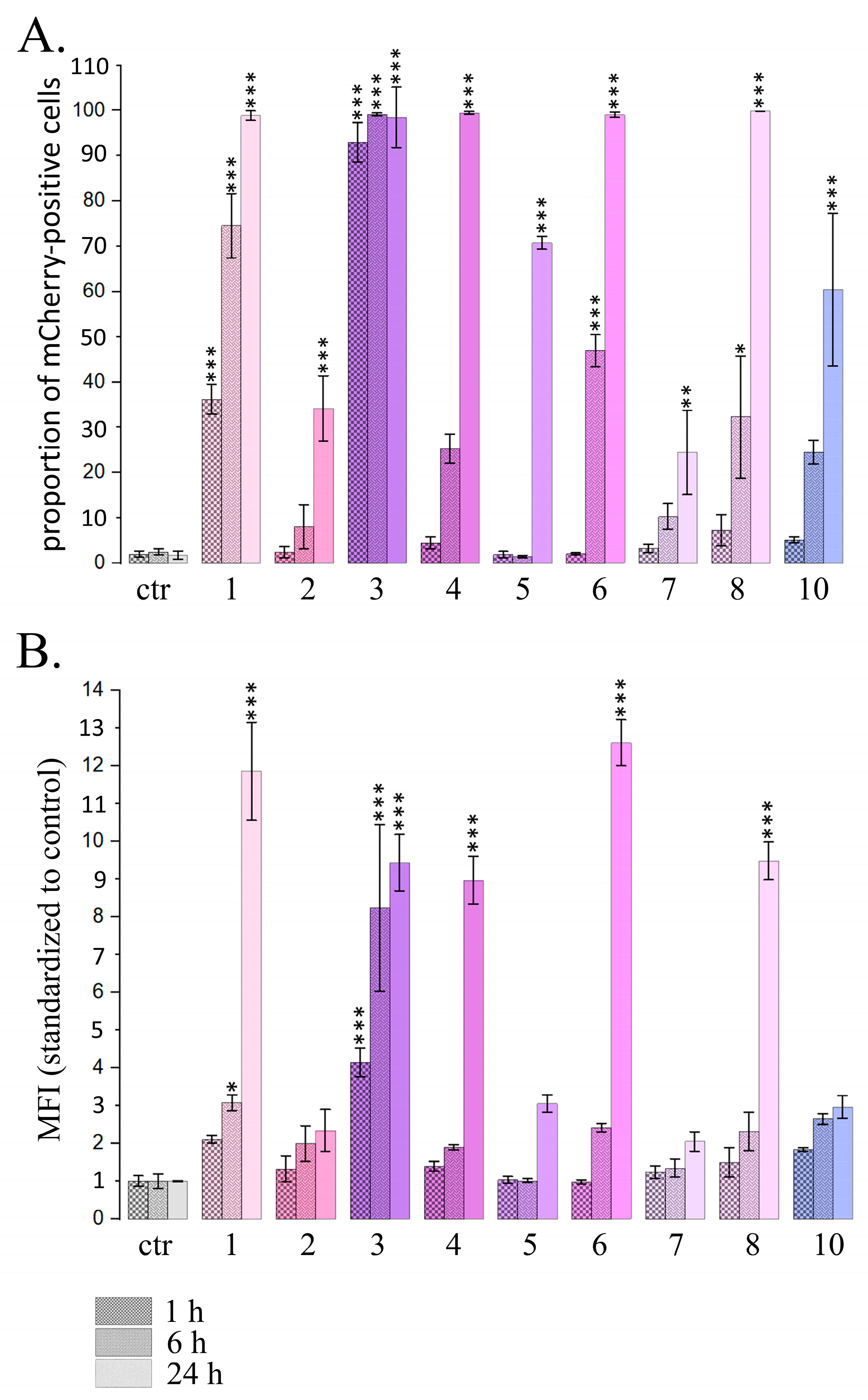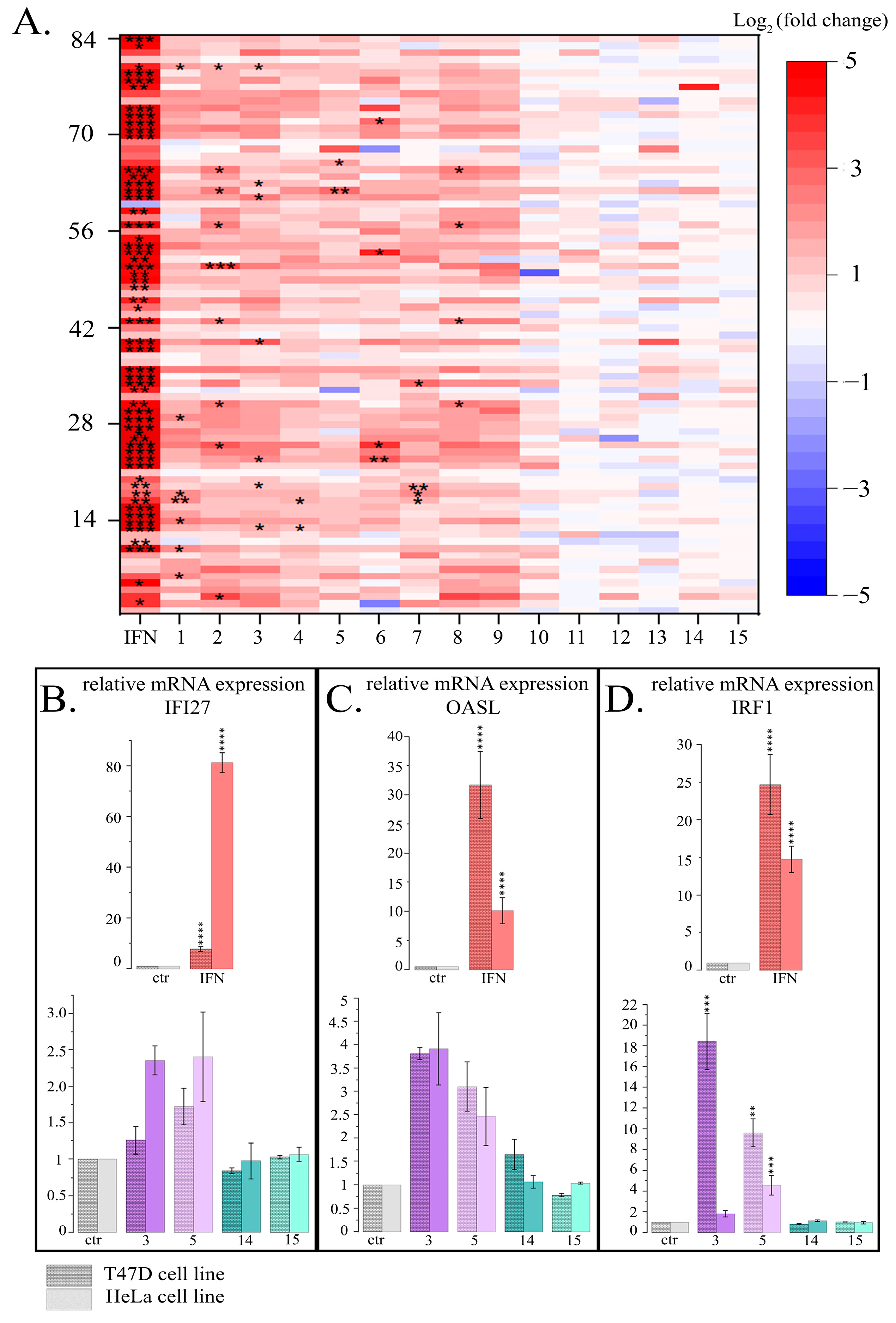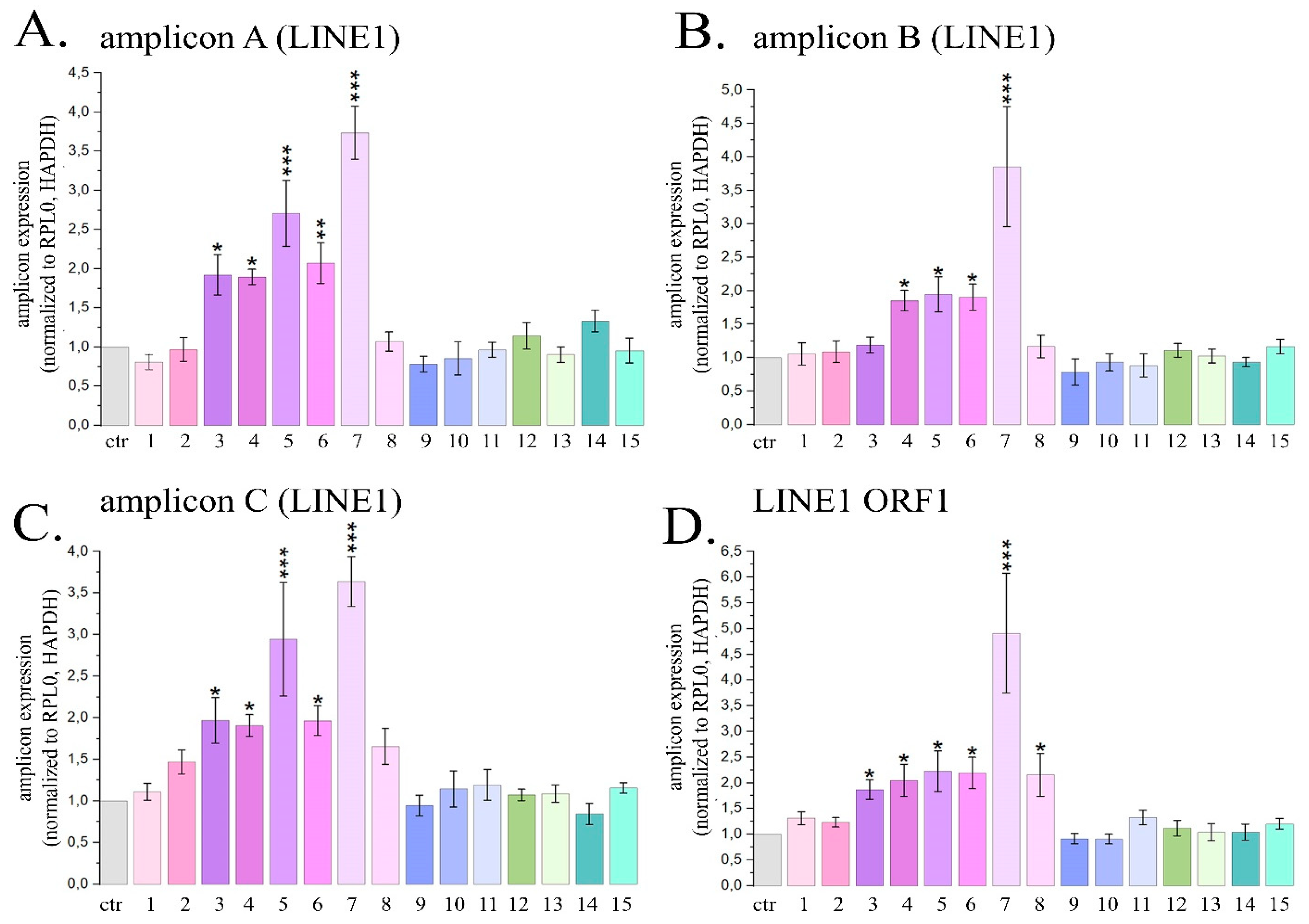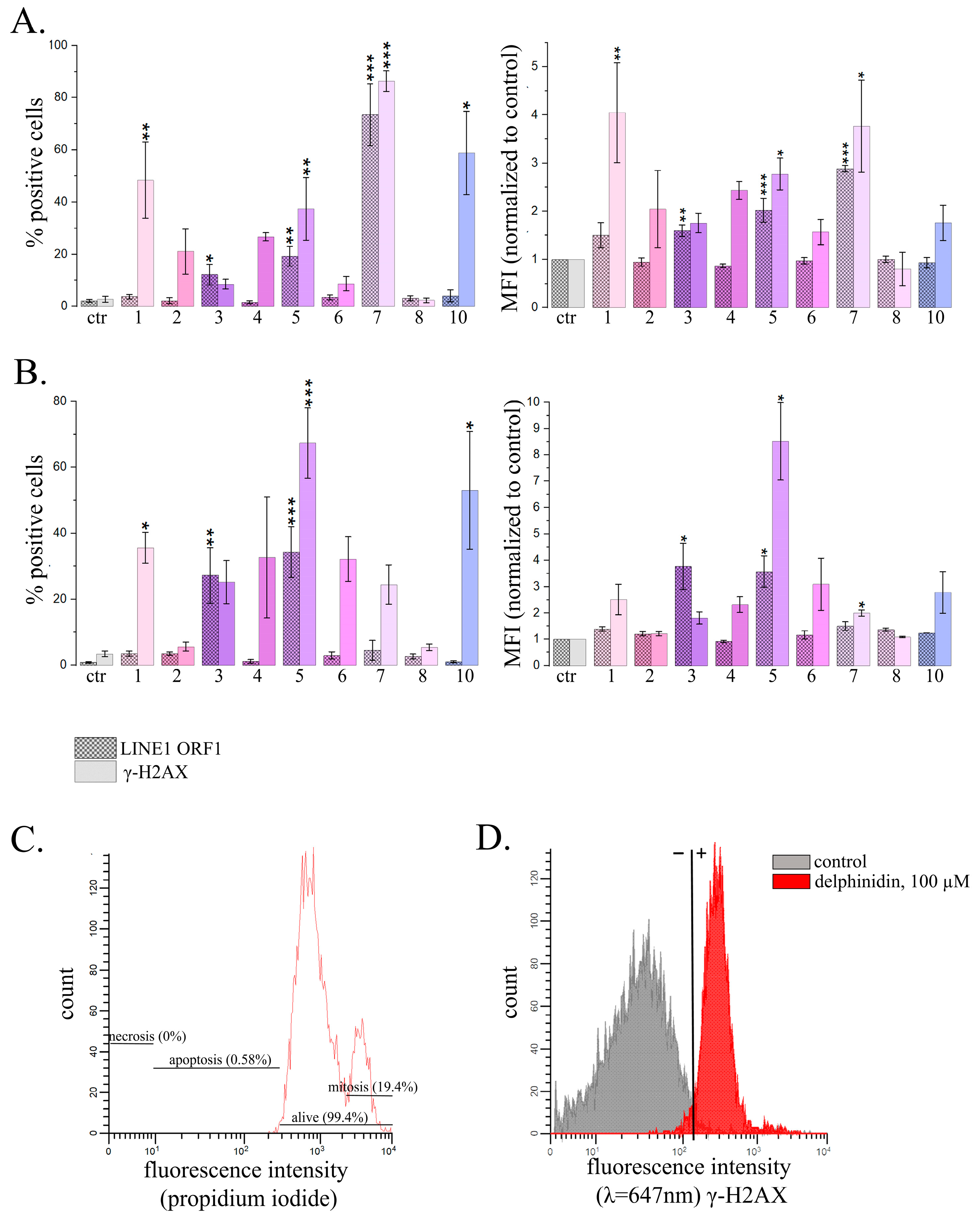Anticancer Plant Secondary Metabolites Evicting Linker Histone H1.2 from Chromatin Activate Type I Interferon Signaling
Abstract
1. Introduction
2. Results
2.1. Type I Interferon Signaling Activation by DNA-Binding PSMs
2.1.1. PSM Influence on Reporter mCherry Expression Driven by IFN-Sensitive Response Element
2.1.2. Influence of PSMs on the Expression Pattern of IFN-Responsive Genes
2.2. Induction of LINE1 Expression by Some PSMs
2.2.1. Quantitative Estimation of LINE1 Expression Level in HeLa Cells Treated with PSMs
2.2.2. Analysis of the Amount of ORF1 LINE1 and γ-H2AX Proteins by Flow Cytometry in HeLa Cells Treated with PSM
3. Discussion
4. Materials and Methods
4.1. Cell Culture
4.2. Plant Secondary Metabolites
4.3. Other Chemicals and Reagents
4.4. Quantitative Reverse Transcriptase–Polymerase Chain Reaction for Analysis of Expression of LINE1 and PSM-Induced Interferon Signaling
- LINE1_amplA_F: 5′GCCAAGATGGCCGAATAGGA 3′
- LINE1_amplA_R: 5′AAATCACCCGTCTTCTGCGT 3′
- LINE1_amplB_F: 5′CGAGATCAAACTGCAAGGCG 3′
- LINE1_amplB_R: 5′CCGGCCGCTTTGTTTACCTA 3′
- LINE1_amplC_F: 5′ TAAACAAAGCGGCCGGGAA 3′
- LINE1_amplC_R: 5′ AGAGGTGGAGCCTACAGAGG 3′
- LINE1_ORF1_F: 5′ ACCTGAAAGTGACGGGGAGA 3′
- LINE1_ORF1_R: 5′CCTGCCTTGCTAGATTGGGG 3′
- RPL0 F: 5′CCTTCTCCTTTGGGCTGGTCATCC A 3′
- RPL0 R: 5′CAGACACTGGCAACATTGCGGACAC 3′
- HAPDH F: 5′GTCTCCTCTGACTTCAACAGCG 3′
- HAPDH R: 5′ACCACCCTGTTGCTGTAGCCAA 3′
- IFI27_F: 5′ TGCTCTCACCTCATCAGCAGT 3′
- IFI27_R: 5′ CACAACTCCTCCAATCACAACT 3′
- OASL_F: 5′ GGGACAGAGATGGCACTGAT 3′
- OASL_R: 5′ AAATGCTCCTGCCTCAGAAA 3′
- IRF1_F: 5′ TTTGTATCGGCCTGTGTGAATG 3′
- IRF1_R: 5′ AAGCATGGCTGGGACATCA 3′
4.5. Analysis of ISRE-mCherry Reporter Activation in HeLa-TI-ISRE-mCherry Cells by Flow Cytometry
4.6. Analysis of PSM Induced LINE1 Activation by Immunofluorescent Antibody Staining and Flow Cytometry
4.7. Annexin-FITC/Propidium Iodide Double Staining
4.8. Statistical Analysis
5. Conclusions
Supplementary Materials
Author Contributions
Funding
Institutional Review Board Statement
Informed Consent Statement
Data Availability Statement
Acknowledgments
Conflicts of Interest
Abbreviations
| ANOVA | Analysis of Variance |
| DAMPs | Danger-associated Molecular Patterns |
| EGCG | Epigallocatechin-3-gallate |
| HSTPF | Human Signal Transduction Pathway Finder |
| IFN | Interferon |
| ISRE | Interferon-sensitive Response Element |
| L1 | Long Interspersed Element-1 |
| LINEs (L1) | Long Interspersed Nuclear Elements |
| LPS | Lipopolysaccharide |
| MFI | Mean Fluorescence Intensity |
| NLR | Nod-like-Receptor |
| PRRs | Pattern Recognition Receptors |
| PSMs | Plant Secondary Metabolites |
| RIG-1 | Retinoic Acid-inducible Gene 1 |
| SINEs | Short Interspersed Nuclear Elements |
| SVA | SINE-VNTR-Alus |
| TEs | Transposable Elements |
| TLR | Toll-like Receptor |
References
- Lamartiniere, C.A.; Moore, J.B.; Brown, N.M.; Thompson, R.; Hardin, M.J.; Barnes, S. Genistein suppresses mammary cancer in rats. Carcinogenesis 1995, 16, 2833–2840. [Google Scholar] [CrossRef] [PubMed]
- Bishayee, A. Cancer Prevention and Treatment with Resveratrol: From Rodent Studies to Clinical Trials. Cancer Prev. Res. 2009, 2, 409–418. [Google Scholar] [CrossRef] [PubMed]
- Kisková, T.; Ekmekcioglu, C.; Garajová, M.; Orendáš, P.; Bojková, B.; Bobrov, N.; Jäger, W.; Kassayová, M.; Thalhammer, T. A combination of resveratrol and melatonin exerts chemopreventive effects in N-methyl-N-nitrosourea-induced rat mammary carcinogenesis. Eur. J. Cancer Prev. 2012, 21, 163–170. [Google Scholar] [CrossRef] [PubMed]
- Whitsett Jr, T.G.; Lamartiniere, C.A. Genistein and resveratrol: Mammary cancer chemoprevention and mechanisms of action in the rat. Expert Rev. Anticancer. Ther. 2006, 6, 1699–1706. [Google Scholar] [CrossRef]
- Fantini, M.; Benvenuto, M.; Masuelli, L.; Frajese, G.V.; Tresoldi, I.; Modesti, A.; Bei, R. In Vitro and in Vivo Antitumoral Effects of Combinations of Polyphenols, or Polyphenols and Anticancer Drugs: Perspectives on Cancer Treatment. Int. J. Mol. Sci. 2015, 16, 9236–9282. [Google Scholar] [CrossRef]
- Jantan, I.; Ahmad, W.; Bukhari, S.N.A. Plant-derived immunomodulators: An insight on their preclinical evaluation and clinical trials. Front. Plant Sci. 2015, 6, 655. [Google Scholar] [CrossRef]
- Pezzuto, J.M. Resveratrol: Twenty Years of Growth, Development and Controversy. Biomol. Ther. 2019, 27, 1–14. [Google Scholar] [CrossRef]
- Russo, M.; Russo, G.L.; Daglia, M.; Kasi, P.D.; Ravi, S.; Nabavi, S.M. Understanding genistein in cancer: The “good” and the “bad” effects: A review. Food Chem. 2015, 196, 589–600. [Google Scholar] [CrossRef]
- Chen, Y.-X.; Gao, Q.-Y.; Zou, T.-H.; Wang, B.-M.; Liu, S.-D.; Sheng, J.-Q.; Ren, J.-L.; Zou, X.-P.; Liu, Z.-J.; Song, Y.-Y.; et al. Berberine versus placebo for the prevention of recurrence of colorectal adenoma: A multicentre, double-blinded, randomised controlled study. Lancet Gastroenterol. Hepatol. 2020, 5, 267–275. [Google Scholar] [CrossRef]
- Thomas, R.; Williams, M.; Sharma, H.; Chaudry, A.; Bellamy, P. A double-blind, placebo-controlled randomised trial evaluating the effect of a polyphenol-rich whole food supplement on PSA progression in men with prostate cancer—The UK NCRN Pomi-T study. Prostate Cancer Prostatic Dis. 2014, 17, 180–186. [Google Scholar] [CrossRef]
- Zhang, H.; Gordon, R.; Li, W.; Yang, X.; Pattanayak, A.; Fowler, G.; Zhang, L.; Catalona, W.J.; Ding, Y.; Xu, L.; et al. Genistein treatment duration effects biomarkers of cell motility in human prostate. PLoS ONE 2019, 14, e0214078. [Google Scholar] [CrossRef]
- Britton, R.G.; Kovoor, C.; Brown, K. Direct molecular targets of resveratrol: Identifying key interactions to unlock complex mechanisms. Ann. New York Acad. Sci. 2015, 1348, 124–133. [Google Scholar] [CrossRef] [PubMed]
- Khan, F.; Niaz, K.; Maqbool, F.; Hassan, F.I.; Abdollahi, M.; Venkata, K.C.N.; Nabavi, S.M.; Bishayee, A. Molecular Targets Underlying the Anticancer Effects of Quercetin: An Update. Nutrients 2016, 8, 529. [Google Scholar] [CrossRef] [PubMed]
- Nagaraju, G.P.; Zafar, S.F.; El-Rayes, B.F. Pleiotropic effects of genistein in metabolic, inflammatory, and malignant diseases. Nutr. Rev. 2013, 71, 562–572. [Google Scholar] [CrossRef] [PubMed]
- Qadir, M.I.; Naqvi, S.T.Q.; Muhammad, S.A. Curcumin: A Polyphenol with Molecular Targets for Cancer Control. Asian Pac. J. Cancer Prev. 2016, 17, 2735–2739. [Google Scholar] [PubMed]
- N’soukpoé-Kossi, C.; Bourassa, P.; Mandeville, J.; Bekale, L.; Tajmir-Riahi, H. Structural modeling for DNA binding to antioxidants resveratrol, genistein and curcumin. J. Photochem. Photobiol. B Biol. 2015, 151, 69–75. [Google Scholar] [CrossRef]
- Kanakis, C.D.; Tarantilis, P.A.; Polissiou, M.G.; Tajmir-Riahi, H.-A. Interaction of Antioxidant Flavonoids with tRNA: Intercalation or External Binding and Comparison with Flavonoid-DNA Adducts. DNA Cell Biol. 2006, 25, 116–123. [Google Scholar] [CrossRef]
- Nafisi, S.; Hashemi, M.; Rajabi, M.; Tajmir-Riahi, H.A. DNA Adducts with Antioxidant Flavonoids: Morin, Apigenin, and Naringin. DNA Cell Biol. 2008, 27, 433–442. [Google Scholar] [CrossRef]
- Bhattacharjee, S.; Chakraborty, S.; Sengupta, P.K.; Bhowmik, S. Exploring the Interactions of the Dietary Plant Flavonoids Fisetin and Naringenin with G-Quadruplex and Duplex DNA, Showing Contrasting Binding Behavior: Spectroscopic and Molecular Modeling Approaches. J. Phys. Chem. B 2016, 120, 8942–8952. [Google Scholar] [CrossRef]
- Galindo-Murillo, R.; Cheatham, T.E. Computational DNA binding studies of (–)-epigallocatechin-3-gallate. J. Biomol. Struct. Dyn. 2017, 36, 3311–3323. [Google Scholar] [CrossRef]
- Khurana, S.; Kukreti, S.; Kaushik, M. Designing a two-stage colorimetric sensing strategy based on citrate reduced gold nanoparticles: Sequential detection of Sanguinarine (anticancer drug) and visual sensing of DNA. Spectrochim. Acta Part A Mol. Biomol. Spectrosc. 2020, 246, 119039. [Google Scholar] [CrossRef]
- Basu, A.; Kumar, G.S. Biophysical studies on curcumin–deoxyribonucleic acid interaction: Spectroscopic and calorimetric approach. Int. J. Biol. Macromol. 2013, 62, 257–264. [Google Scholar] [CrossRef] [PubMed]
- Pandya, N.; Khan, E.; Jain, N.; Satham, L.; Singh, R.; Makde, R.D.; Mishra, A.; Kumar, A. Curcumin analogs exhibit anti-cancer activity by selectively targeting G-quadruplex forming c-myc promoter sequence. Biochimie 2020, 180, 205–221. [Google Scholar] [CrossRef] [PubMed]
- Mikutis, G.; Karaköse, H.; Jaiswal, R.; LeGresley, A.; Islam, T.; Fernandez-Lahore, M.; Kuhnert, N. Phenolic promiscuity in the cell nucleus—Epigallocatechingallate (EGCG) and theaflavin-3,3′-digallate from green and black tea bind to model cell nuclear structures including histone proteins, double stranded DNA and telomeric quadruplex DNA. Food Funct. 2012, 4, 328–337. [Google Scholar] [CrossRef] [PubMed]
- Bhattacharjee, S.; Chakraborty, S.; Chorell, E.; Sengupta, P.K.; Bhowmik, S. Importance of the hydroxyl substituents in the B–ring of plant flavonols on their preferential binding interactions with VEGF G–quadruplex DNA: Multi-spectroscopic and molecular modeling studies. Int. J. Biol. Macromol. 2018, 118, 629–639. [Google Scholar] [CrossRef]
- Dickerhoff, J.; Brundridge, N.; McLuckey, S.A.; Yang, D. Berberine Molecular Recognition of the Parallel MYC G-Quadruplex in Solution. J. Med. Chem. 2021, 64, 16205–16212. [Google Scholar] [CrossRef]
- Jarosova, P.; Paroulek, P.; Rajecky, M.; Rajecka, V.; Taborska, E.; Eritja, R.; Aviñó, A.; Mazzini, S.; Gargallo, R.; Taborsky, P. Naturally occurring quaternary benzo[c]phenanthridine alkaloids selectively stabilize G-quadruplexes. Phys. Chem. Chem. Phys. 2018, 20, 21772–21782. [Google Scholar] [CrossRef]
- Tawani, A.; Mishra, S.K.; Kumar, A. Structural insight for the recognition of G-quadruplex structure at human c-myc promoter sequence by flavonoid Quercetin. Sci. Rep. 2017, 7, 1–13. [Google Scholar] [CrossRef]
- Salem, A.A.; El Haty, I.A.; Abdou, I.M.; Mu, Y. Interaction of human telomeric G-quadruplex DNA with thymoquinone: A possible mechanism for thymoquinone anticancer effect. Biochim. et Biophys. Acta (BBA)—Gen. Subj. 2015, 1850, 329–342. [Google Scholar] [CrossRef]
- Luzhin, A.; Rajan, P.; Safina, A.; Leonova, K.; Stablewski, A.; Wang, J.; Robinson, D.; Isaeva, N.; Kantidze, O.; Gurova, K. Comparison of cell response to chromatin and DNA damage. Nucleic Acids Res. 2023, 51, 11836–11855. [Google Scholar] [CrossRef]
- Kirsanov, K.I.; Kotova, E.; Makhov, P.; Golovine, K.; Lesovaya, E.A.; Kolenko, V.M.; Yakubovskaya, M.G.; Tulin, A.V. Minor grove binding ligands disrupt PARP-1 activation pathways. Oncotarget 2014, 5, 428–437. [Google Scholar] [CrossRef][Green Version]
- Vlasova, O.; Antonova, I.; Zenkov, R.; Naberezhnov, D.; Belitsky, G.; Borunova, A.; Zabotina, T.; García-Gomis, D.; Safina, A.; Gurova, K.; et al. Anticancer Plant Secondary Metabolites Induce Linker Histone Depletion from Chromatin. Front. Biosci. 2024, 29, 275. [Google Scholar] [CrossRef] [PubMed]
- Izquierdo-Bouldstridge, A.; Bustillos, A.; Bonet-Costa, C.; Aribau-Miralbés, P.; García-Gomis, D.; Dabad, M.; Esteve-Codina, A.; Pascual-Reguant, L.; Peiró, S.; Esteller, M.; et al. Histone H1 depletion triggers an interferon response in cancer cells via activation of heterochromatic repeats. Nucleic Acids Res. 2017, 45, 11622–11642. [Google Scholar] [CrossRef] [PubMed]
- Goudar, S.P.; Shah, S.S.; Shirali, G.S. Echocardiography of Coarctation of the Aorta, Aortic Arch Hypoplasia, and Arch Interruption: Strategies for Evaluation of the Aortic Arch. Cardiol Young 2016, 26, 1553–1562. [Google Scholar] [CrossRef] [PubMed]
- Healton, S.E.; Pinto, H.D.; Mishra, L.N.; Hamilton, G.A.; Wheat, J.C.; Swist-Rosowska, K.; Shukeir, N.; Dou, Y.; Steidl, U.; Jenuwein, T.; et al. H1 linker histones silence repetitive elements by promoting both histone H3K9 methylation and chromatin compaction. Proc. Natl. Acad. Sci. USA 2020, 117, 14251–14258. [Google Scholar] [CrossRef]
- Pang, B.; Qiao, X.; Janssen, L.; Velds, A.; Groothuis, T.; Kerkhoven, R.; Nieuwland, M.; Ovaa, H.; Rottenberg, S.; van Tellingen, O.; et al. Drug-induced histone eviction from open chromatin contributes to the chemotherapeutic effects of doxorubicin. Nat. Commun. 2013, 4, 1908–1913. [Google Scholar] [CrossRef]
- Safina, A.; Cheney, P.; Pal, M.; Brodsky, L.; Ivanov, A.; Kirsanov, K.; Lesovaya, E.; Naberezhnov, D.; Nesher, E.; Koman, I.; et al. FACT is a sensor of DNA torsional stress in eukaryotic cells. Nucleic Acids Res. 2017, 45, 1925–1945. [Google Scholar] [CrossRef]
- Leonova, K.; Safina, A.; Nesher, E.; Sandlesh, P.; Pratt, R.; Burkhart, C.; Lipchick, B.; Gitlin, I.; Frangou, C.; Koman, I.; et al. TRAIN (Transcription of Repeats Activates INterferon) in response to chromatin destabilization induced by small molecules in mammalian cells. eLife 2018, 7, e30842. [Google Scholar] [CrossRef]
- Chen, M.; Brackett, C.M.; Burdelya, L.G.; Punnanitinont, A.; Patnaik, S.K.; Matsuzaki, J.; Odunsi, A.O.; Gudkov, A.V.; Singh, A.K.; Repasky, E.A.; et al. Stimulation of an anti-tumor immune response with “chromatin-damaging” therapy. Cancer Immunol. Immunother. 2021, 70, 2073–2086. [Google Scholar] [CrossRef]
- Stilp, A.-C.; Scherer, M.; König, P.; Fürstberger, A.; Kestler, H.A.; Stamminger, T. The chromatin remodeling protein ATRX positively regulates IRF3-dependent type I interferon production and interferon-induced gene expression. PLoS Pathog. 2022, 18, e1010748. [Google Scholar] [CrossRef]
- Platanias, L.C. Mechanisms of type-I- and type-II-interferon-mediated signalling. Nat. Rev. Immunol. 2005, 5, 375–386. [Google Scholar] [CrossRef]
- Petrova, L.; Bunz, F. Interferons in Colorectal Cancer Pathogenesis and Therapy. Dis. Res. 2024, 4, 31–39. [Google Scholar] [CrossRef] [PubMed]
- Lin, C.-J.; Lin, H.-J.; Chen, T.-H.; Hsu, Y.-A.; Liu, C.-S.; Hwang, G.-Y.; Wan, L. Polygonum cuspidatum and Its Active Components Inhibit Replication of the Influenza Virus through Toll-Like Receptor 9-Induced Interferon Beta Expression. PLoS ONE 2015, 10, e0117602. [Google Scholar] [CrossRef] [PubMed]
- Alesci, A.; Nicosia, N.; Fumia, A.; Giorgianni, F.; Santini, A.; Cicero, N. Resveratrol and Immune Cells: A Link to Improve Human Health. Molecules 2022, 27, 424. [Google Scholar] [CrossRef] [PubMed]
- Kim, J.-H.; Weeratunga, P.; Kim, M.S.; Nikapitiya, C.; Lee, B.-H.; Uddin, B.; Kim, T.-H.; Yoon, J.-E.; Park, C.; Ma, J.Y.; et al. Inhibitory effects of an aqueous extract from Cortex Phellodendri on the growth and replication of broad-spectrum of viruses in vitro and in vivo. BMC Complement. Altern. Med. 2016, 16, 1–13. [Google Scholar] [CrossRef]
- Seo, D.J.; Choi, C. Inhibitory mechanism of five natural flavonoids against murine norovirus. Phytomedicine 2017, 30, 59–66. [Google Scholar] [CrossRef]
- Kataoka, H.; Saeki, A.; Hasebe, A.; Shibata, K.; Into, T. Naringenin suppresses Toll-like receptor 2-mediated inflammatory responses through inhibition of receptor clustering on lipid rafts. Food Sci. Nutr. 2021, 9, 963–972. [Google Scholar] [CrossRef]
- Yu, J.; Shi, H.; Song, K.; Yang, Y.; Li, X.; Peng, L.; Fu, B.; Yi, P. Naringenin Improves Innate Immune Suppression after PRRSV Infection by Reactivating the RIG-I-MAVS Signaling Pathway, Promoting the Production of IFN-I. Viruses 2023, 15, 2172. [Google Scholar] [CrossRef]
- Sunthamala, N.; Suebsamran, C.; Khruaphet, N.; Sankla, N.; Janpirom, J.; Khankhum, S.; Thiwthong, R.; Chuncher, S. Sanguinarine and Chelidonine Synergistically Induce Endosomal Toll-like Receptor and M1-Associated Mediators Expression. J. Pure Appl. Microbiol. 2020, 14, 2351–2361. [Google Scholar] [CrossRef]
- Bhaskar, S.; Helen, A. Quercetin modulates toll-like receptor-mediated protein kinase signaling pathways in oxLDL-challenged human PBMCs and regulates TLR-activated atherosclerotic inflammation in hypercholesterolemic rats. Mol. Cell. Biochem. 2016, 423, 53–65. [Google Scholar] [CrossRef]
- Zenkov, R.G.; Kirsanov, K.I.; Ogloblina, A.M.; Vlasova, O.A.; Naberezhnov, D.S.; Karpechenko, N.Y.; Fetisov, T.I.; Lesovaya, E.A.; Belitsky, G.A.; Dolinnaya, N.G.; et al. Effects of G-Quadruplex-Binding Plant Secondary Metabolites on c-MYC Expression. Int. J. Mol. Sci. 2022, 23, 9209. [Google Scholar] [CrossRef]
- De Cecco, M.; Ito, T.; Petrashen, A.P.; Elias, A.E.; Skvir, N.J.; Criscione, S.W.; Caligiana, A.; Brocculi, G.; Adney, E.M.; Boeke, J.D.; et al. L1 drives IFN in senescent cells and promotes age-associated inflammation. Nature 2019, 566, 73–78. [Google Scholar] [CrossRef] [PubMed]
- Pradeu, T.; Thomma, B.P.; Girardin, S.E.; Lemaitre, B. The conceptual foundations of innate immunity: Taking stock 30 years later. Immunity 2024, 57, 613–631. [Google Scholar] [CrossRef] [PubMed]
- Amarante-Mendes, G.P.; Adjemian, S.; Branco, L.M.; Zanetti, L.C.; Weinlich, R.; Bortoluci, K.R. Pattern Recognition Receptors and the Host Cell Death Molecular Machinery. Front. Immunol. 2018, 9, 2379. [Google Scholar] [CrossRef] [PubMed]
- Carroll, S.L.; Pasare, C.; Barton, G.M. Control of adaptive immunity by pattern recognition receptors. Immunity 2024, 57, 632–648. [Google Scholar] [CrossRef]
- Silverstein, A.M. Paul Ehrlich’s Passion: The Origins of His Receptor Immunology. Cell. Immunol. 1999, 194, 213–221. [Google Scholar] [CrossRef]
- Kroemer, G.; Montégut, L.; Kepp, O.; Zitvogel, L. The danger theory of immunity revisited. Nat. Rev. Immunol. 2024, 24, 912–928. [Google Scholar] [CrossRef]
- Matzinger, P. Tolerance, Danger, and the Extended Family. Annu. Rev. Immunol. 1994, 12, 991–1045. [Google Scholar] [CrossRef]
- Matzinger, P. The Danger Model: A Renewed Sense of Self. Science 2002, 296, 301–305. [Google Scholar] [CrossRef]
- Ancona, G.; Alagna, L.; Alteri, C.; Palomba, E.; Tonizzo, A.; Pastena, A.; Muscatello, A.; Gori, A.; Bandera, A. Gut and airway microbiota dysbiosis and their role in COVID-19 and long-COVID. Front. Immunol. 2023, 14, 1080043. [Google Scholar] [CrossRef]
- Stetson, D.B.; Medzhitov, R. Type I Interferons in Host Defense. Immunity 2006, 25, 373–381. [Google Scholar] [CrossRef]
- Ullah, T.R.; Balka, K.R.; Ambrose, R.L.; Pépin, G.; Wilce, M.C.J.; Wilce, J.A.; Thomas, B.J.; De Nardo, D.; Williams, B.R.G.; Gantier, M.P. Genistein Targets STING-Driven Antiviral Responses. mBio 2022, 13, e0206422. [Google Scholar] [CrossRef] [PubMed]
- LeCher, J.C.; Diep, N.; Krug, P.W.; Hilliard, J.K. Genistein Has Antiviral Activity against Herpes B Virus and Acts Synergistically with Antiviral Treatments to Reduce Effective Dose. Viruses 2019, 11, 499. [Google Scholar] [CrossRef] [PubMed]
- Aziz, N.; Son, Y.-J.; Cho, J.Y. Thymoquinone Suppresses IRF-3-Mediated Expression of Type I Interferons via Suppression of TBK. Int. J. Mol. Sci. 2018, 19, 1355. [Google Scholar] [CrossRef]
- Lee, M.H.; Seo, D.J.; Kang, J.-H.; Oh, S.H.; Choi, C. Expression of antiviral cytokines in Crandell-Reese feline kidney cells pretreated with Korean red ginseng extract or ginsenosides. Food Chem. Toxicol. 2014, 70, 19–25. [Google Scholar] [CrossRef] [PubMed]
- Li, S.; Yang, L.-J.; Wang, P.; He, Y.-J.; Huang, J.-M.; Liu, H.-W.; Shen, X.-F.; Wang, F. Dietary apigenin potentiates the inhibitory effect of interferon-α on cancer cell viability through inhibition of 26S proteasome-mediated interferon receptor degradation. Food Nutr. Res. 2016, 60, 31288. [Google Scholar] [CrossRef] [PubMed]
- E Volkman, H.; Stetson, D.B. The enemy within: Endogenous retroelements and autoimmune disease. Nat. Immunol. 2014, 15, 415–422. [Google Scholar] [CrossRef]
- Molagoda, I.M.N.; Athapaththu, A.M.G.K.; Choi, Y.H.; Park, C.; Jin, C.-Y.; Kang, C.-H.; Lee, M.-H.; Kim, G.-Y. Fisetin Inhibits NLRP3 Inflammasome by Suppressing TLR4/MD2-Mediated Mitochondrial ROS Production. Antioxidants 2021, 10, 1215. [Google Scholar] [CrossRef]
- Jiang, K.; Yang, J.; Xue, G.; Dai, A.; Wu, H. Fisetin Ameliorates the Inflammation and Oxidative Stress in Lipopolysaccharide-Induced Endometritis. J. Inflamm. Res. 2021, ume 14, 2963–2978. [Google Scholar] [CrossRef]
- Huang, X.; Shen, H.; Liu, Y.; Qiu, S.; Guo, Y. Fisetin attenuates periodontitis through FGFR1/TLR4/NLRP3 inflammasome pathway. Int. Immunopharmacol. 2021, 95, 107505. [Google Scholar] [CrossRef]
- Lani, R.; Teoh, B.-T.; Sam, S.-S.; AbuBakar, S.; Hassandarvish, P. Fisetin Modulates Toll-like Receptor-Mediated Innate Antiviral Response in Chikungunya Virus-Infected Hepatocellular Carcinoma Huh7 Cells. Immuno 2022, 2, 703–719. [Google Scholar] [CrossRef]
- Domiciano, T.P.; Wakita, D.; Jones, H.D.; Crother, T.R.; Verri, W.A., Jr.; Arditi, M.; Shimada, K. Quercetin Inhibits Inflammasome Activation by Interfering with ASC Oligomerization and Prevents Interleukin-1 Mediated Mouse Vasculitis. Sci. Rep. 2017, 7, 41539. [Google Scholar] [CrossRef] [PubMed]
- Alattar, A.; Alshaman, R.; Althobaiti, Y.S.; Soliman, G.M.; Ali, H.S.; Khubrni, W.S.; Koh, P.O.; Rehman, N.U.; Shah, F.A. Quercetin Alleviated Inflammasome-Mediated Pyroptosis and Modulated the mTOR/P70S6/P6/eIF4E/4EBP1 Pathway in Ischemic Stroke. Pharmaceuticals 2023, 16, 1182. [Google Scholar] [CrossRef] [PubMed]
- Malaguarnera, L. Influence of Resveratrol on the Immune Response. Nutrients 2019, 11, 946. [Google Scholar] [CrossRef] [PubMed]
- Wang, B.; Bellot, G.L.; Iskandar, K.; Chong, T.W.; Goh, F.Y.; Tai, J.J.; Schwarz, H.; Wong, S.C.; Pervaiz, S. Resveratrol attenuates TLR-4 mediated inflammation and elicits therapeutic potential in models of sepsis. Sci. Rep. 2020, 10, 1–17. [Google Scholar] [CrossRef]
- Jeong, J.-W.; Lee, H.H.; Han, M.H.; Kim, G.-Y.; Kim, W.-J.; Choi, Y.H. Anti-inflammatory effects of genistein via suppression of the toll-like receptor 4-mediated signaling pathway in lipopolysaccharide-stimulated BV2 microglia. Chem. Interactions 2014, 212, 30–39. [Google Scholar] [CrossRef]
- Bae, C.H.; Jeon, B.S.; Choi, Y.S.; Song, S.-Y.; Kim, Y.-D. Delphinidin Inhibits LPS-Induced MUC8 and MUC5B Expression Through Toll-like Receptor 4-Mediated ERK1/2 and p38 MAPK in Human Airway Epithelial Cells. Clin. Exp. Otorhinolaryngol. 2014, 7, 198–204. [Google Scholar] [CrossRef]
- Miazzi, M.M.; Pasqualone, A.; Zammit-Mangion, M.; Savoia, M.A.; Fanelli, V.; Procino, S.; Gadaleta, S.; Aurelio, F.L.; Montemurro, C. A Glimpse into the Genetic Heritage of the Olive Tree in Malta. Agriculture 2024, 14, 495. [Google Scholar] [CrossRef]
- Chang, S.; Li, X.; Zheng, Y.; Shi, H.; Zhang, D.; Jing, B.; Chen, Z.; Qian, G.; Zhao, G. Kaempferol exerts a neuroprotective effect to reduce neuropathic pain throughTLR4/NF-ĸBsignaling pathway. Phytotherapy Res. 2022, 36, 1678–1691. [Google Scholar] [CrossRef]
- Meng, Y.-Y.; Liu, Y.; Hu, Z.-F.; Zhang, Y.; Ni, J.; Ma, Z.-G.; Liao, H.-H.; Wu, Q.-Q.; Tang, Q.-Z. Sanguinarine Attenuates Lipopolysaccharide-induced Inflammation and Apoptosis by Inhibiting the TLR4/NF-κB Pathway in H9c2 Cardiomyocytes. Curr. Med. Sci. 2018, 38, 204–211. [Google Scholar] [CrossRef]
- Bao, S.; Cao, Y.; Zhou, H.; Sun, X.; Shan, Z.; Teng, W. Epigallocatechin Gallate (EGCG) Suppresses Lipopolysaccharide-Induced Toll-like Receptor 4 (TLR4) Activity via 67 kDa Laminin Receptor (67LR) in 3T3-L1 Adipocytes. J. Agric. Food Chem. 2015, 63, 2811–2819. [Google Scholar] [CrossRef]
- Chen, B.; Li, Y.-F.; Fang, Z.; Cai, W.-Y.; Tian, Z.-Q.; Li, D.; Wang, Z.-M. Epigallocatechin-3-gallate protects sepsis-induced myocardial dysfunction by inhibiting the nuclear factor-κB signaling pathway. Heliyon 2024, 10, e27163. [Google Scholar] [CrossRef] [PubMed]
- Kim, A.; Lee, C.S. Apigenin reduces the Toll-like receptor-4-dependent activation of NF-κB by suppressing the Akt, mTOR, JNK, and p38-MAPK. Naunyn-Schmiedeberg’s Arch. Pharmacol. 2017, 391, 271–283. [Google Scholar] [CrossRef] [PubMed]
- Xiao, S.; Zhang, P.; Zhang, G.; Li, W.; Lin, H.; Hu, X. Inhibition of toll-like receptor 4 activation by apigenin and chrysin via competition for sites and conformational changes. Int. J. Biol. Macromol. 2023, 252, 126415. [Google Scholar] [CrossRef] [PubMed]
- Zhao, B.; Zhang, S.; Amin, N.; Pan, J.; Wu, F.; Shen, G.; Tan, M.; Shi, Z.; Geng, Y. Thymoquinone regulates microglial M1/M2 polarization after cerebral ischemia-reperfusion injury via the TLR4 signaling pathway. NeuroToxicology 2024, 101, 54–67. [Google Scholar] [CrossRef] [PubMed]
- Gao, H.; Kang, N.; Hu, C.; Zhang, Z.; Xu, Q.; Liu, Y.; Yang, S. Ginsenoside Rb1 exerts anti-inflammatory effects in vitro and in vivo by modulating toll-like receptor 4 dimerization and NF-kB/MAPKs signaling pathways. Phytomedicine 2020, 69, 153197. [Google Scholar] [CrossRef]
- Rostom, B.; Karaky, R.; Kassab, I.; Veitía, M.S.-I. Coumarins derivatives and inflammation: Review of their effects on the inflammatory signaling pathways. Eur. J. Pharmacol. 2022, 922, 174867. [Google Scholar] [CrossRef]






| Type of Gene Products | Gene Products | Number of Genes |
|---|---|---|
| IFNs (21) | IFN-α; IFN-β; receptor ligands | 5 genes |
| IFN-γ; receptor ligands | 1 genes | |
| Hematopoietin & IFN class (D200-domain) cytokine receptor ligands | 10 genes | |
| Other IFN related genes | 5 | |
| IFN receptors (37) | IFN-α and IFN-β receptors | 2 |
| IFN-γ receptors | 2 | |
| Hematopoietin, IFN class (D200-domain) receptors | 28 | |
| IFN regulatory factors (9) | 9 | |
| IFN-responsive genes (23) | Response to virus | 13 * |
| Transcriptional regulation | 2 * | |
| Other IFN responsive genes | 8 |
Disclaimer/Publisher’s Note: The statements, opinions and data contained in all publications are solely those of the individual author(s) and contributor(s) and not of MDPI and/or the editor(s). MDPI and/or the editor(s) disclaim responsibility for any injury to people or property resulting from any ideas, methods, instructions or products referred to in the content. |
© 2025 by the authors. Licensee MDPI, Basel, Switzerland. This article is an open access article distributed under the terms and conditions of the Creative Commons Attribution (CC BY) license (https://creativecommons.org/licenses/by/4.0/).
Share and Cite
Vlasova, O.; Antonova, I.; Magomedova, K.; Osipova, A.; Shtompel, P.; Borunova, A.; Zabotina, T.; Belitsky, G.; Budunova, I.; Jordan, A.; et al. Anticancer Plant Secondary Metabolites Evicting Linker Histone H1.2 from Chromatin Activate Type I Interferon Signaling. Int. J. Mol. Sci. 2025, 26, 375. https://doi.org/10.3390/ijms26010375
Vlasova O, Antonova I, Magomedova K, Osipova A, Shtompel P, Borunova A, Zabotina T, Belitsky G, Budunova I, Jordan A, et al. Anticancer Plant Secondary Metabolites Evicting Linker Histone H1.2 from Chromatin Activate Type I Interferon Signaling. International Journal of Molecular Sciences. 2025; 26(1):375. https://doi.org/10.3390/ijms26010375
Chicago/Turabian StyleVlasova, Olga, Irina Antonova, Khamis Magomedova, Alena Osipova, Polina Shtompel, Anna Borunova, Tatiana Zabotina, Gennady Belitsky, Irina Budunova, Albert Jordan, and et al. 2025. "Anticancer Plant Secondary Metabolites Evicting Linker Histone H1.2 from Chromatin Activate Type I Interferon Signaling" International Journal of Molecular Sciences 26, no. 1: 375. https://doi.org/10.3390/ijms26010375
APA StyleVlasova, O., Antonova, I., Magomedova, K., Osipova, A., Shtompel, P., Borunova, A., Zabotina, T., Belitsky, G., Budunova, I., Jordan, A., Kirsanov, K., & Yakubovskaya, M. (2025). Anticancer Plant Secondary Metabolites Evicting Linker Histone H1.2 from Chromatin Activate Type I Interferon Signaling. International Journal of Molecular Sciences, 26(1), 375. https://doi.org/10.3390/ijms26010375






